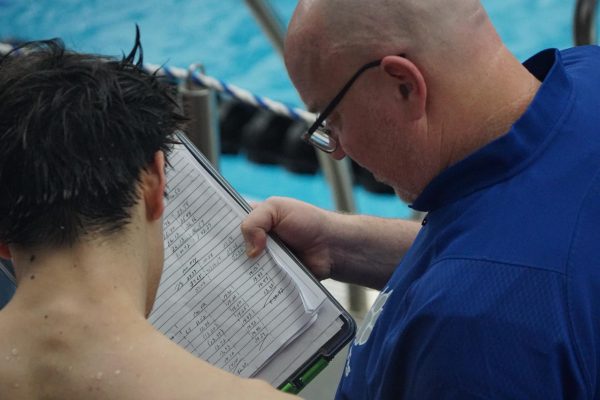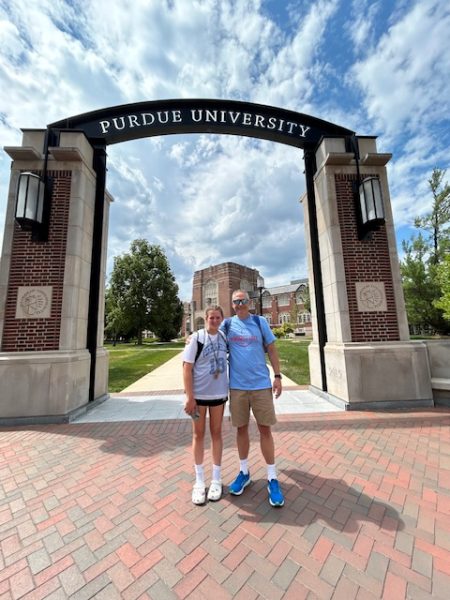English teacher Siobhan Szabo has a busy schedule during the school year. After Szabo wakes up, she gets her kids up, prepares their lunches and takes them to school. When she arrives at school, she takes time to get ready for the school day. She then teaches her five periods: two AP Language & Composition classes, one American Studies class (two periods long) and one World Literature & Composition Honors class.
Many teachers like Szabo have a busy personal and professional schedules throughout the day. Szabo and her husband, who is also a teacher, balance many responsibilities in order to keep up with the demands of being a teacher, coach, parent, spouse, and more.

During her free periods, Szabo takes time to grade, meet with students and catch up on emails. After the school day is fi nished, Szabo leaves to pick her kids up from school, while her husband is coaching, and takes them to soccer practice twice a week. When she gets home, she cooks dinner for her family and helps get her kids ready for bed.
Szabo described the benefits and challenges of living in a two-teacher household.
“The benefits are vacations together…It’s really magical… you just get all this family time all the time,” Szabo said.
Szabo explained that having a spouse who is also a teacher makes a difference because they can understand the workload and responsibilities that come with being a teacher and coach.
“I think some spouses might be resentful of their spouse coaching, but because I know he’s an amazing coach, I know he does so much for these kids, I know it’s his passion, [and] I’m able to support that without being resentful,” Szabo said.
Szabo explained that one of the challenges of working in the same building is talking about work too much, which can get “toxic and unhealthy.” Szabo believes that setting boundaries is a productive solution.
“Trying to create boundaries where [we say,] ‘okay, I don’t want to talk about work anymore, or I’m done talking about this or let’s take a break and like this whole week not talk about it,’”Szabo said.

Szabo described that a benefit of teaching is how rewarding it is. She feels that even though teaching requires her brain to work hard, it is intellectually satisfying.
“[Teaching] feels really meaningful. I love the students and I love my colleagues. My favorite part of my day is just getting to talk and interact…there’s so much interaction…so much creativity,” Szabo said. “[Knowing that] your work has real impact and real importance feels really rewarding.”
The coaching lifestyle makes varsity swim coach and math teacher Jim Pardun’s schedule stacked. He gets to school at 5:45 a.m. during swim season. He then leads practice from 6 a.m. to 8 a.m. After practice, Pardun gets ready for the school day by planning lessons and grading. Pardun teaches his classes and then heads back to the swimming pool for after-school practice from 3:45 a.m. to 5:45 a.m. before going home for the day.
Pardun stays busy before the winter swim season through his side hustle. He works for the Harley Davidson Motorcycle Company teaching people how to ride motorcycles, a job he enjoys a lot.

teacher Paul Brettner. (Kristen Brettner)
Paul Brettner, math teacher and head girls basketball coach, also has a busy schedule during his coaching season. In comparison to Pardun, Brettner also has two children at VHHS.
“Arrive at school at 7:30 a.m. Plan and prepare for classes and practice, or meet with students before school. Teach my five classes and use my preparation time planning and grading, or planning and watching film. Attend practice. Go home and eat with my family. Work on school or basketball for a little while. Spend time with family. Go to bed,” Brettner said.
Brettner’s son, Nolan Brettner (11), described how having his father teach at his high school changed his perspective on school activities.

“I also get to see and relate to how a teacher feels about certain situations, which overall changes my perspective on different activities done in the classroom and in sporting extracurricular activities,” Nolan Brettner said.

